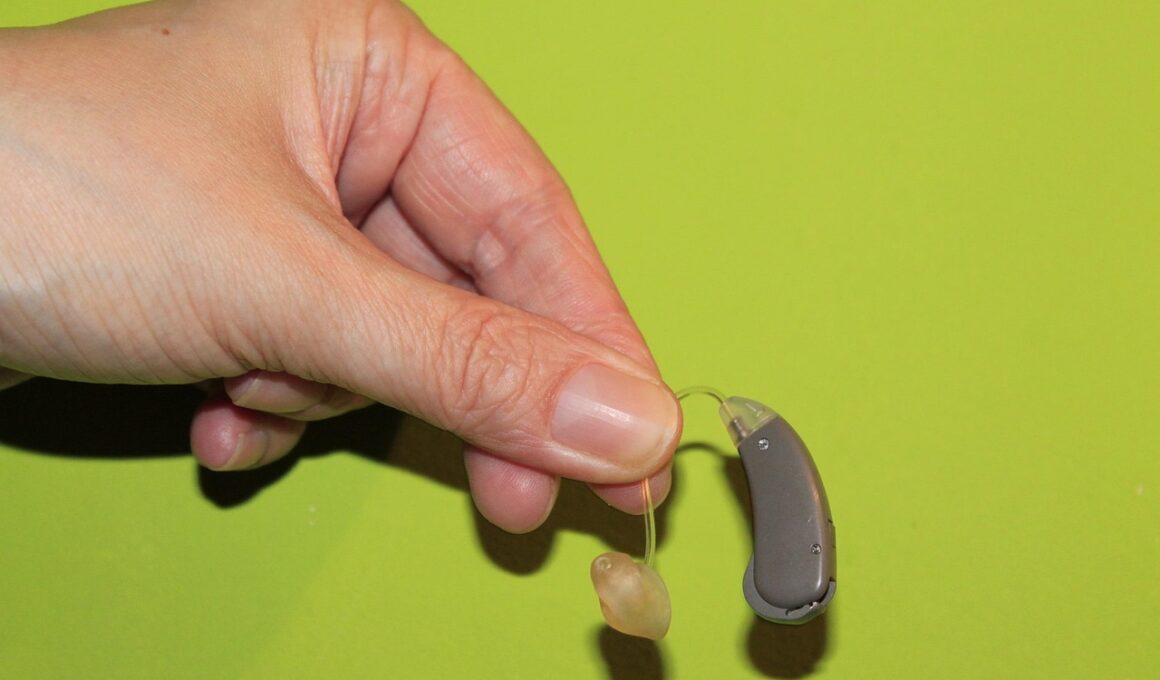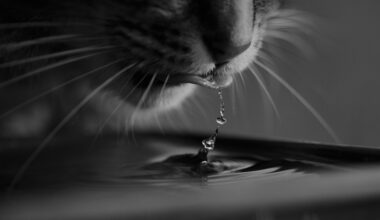Hearing Aids and Assistive Devices for Senior Cats
As your cat ages, you may notice changes in their behavior and health, particularly in their senses. One common issue among senior cats is hearing loss, which can significantly affect their quality of life. Early detection of hearing problems can lead to effective solutions such as hearing aids specially designed for cats. Unlike traditional hearing aids for humans, cat-specific devices are lightweight and comfortable, allowing your feline friend to adapt without feeling burdened by their use. Regular veterinary check-ups are essential to monitor your cat’s auditory health and determine if a hearing aid is a suitable option. Assistive devices can improve your cat’s ability to navigate their environment safely and engage in play. In addition, they encourage greater interaction with their owners, combating loneliness often felt by aging pets. Consider using environmental modifications, such as sound indicators (like bells), and incorporate them into your home to help your cat adjust. Keeping a close eye on their behavior can provide essential insight into their condition and help you create a conducive atmosphere for them as they grow older.
In addition to hearing difficulties, senior cats can experience various vision problems, including cataracts or diminished eyesight. To address these issues, assistive devices specifically designed for feline needs can be invaluable. Just as with hearing aids, visual aids can help senior cats maintain their independence and quality of life, making it easier for them to navigate their surroundings and engage in play. The use of high-contrast toys can enhance visibility and stimulate your cat’s natural hunting instincts while encouraging physical activity. Moreover, specialized lighting can serve to brighten areas where your cat spends time, ensuring that they can see more clearly, especially during darker hours. Regular veterinary evaluations are crucial for detecting changes in vision and advising on potential solutions. Supplementary items like extra safety measures, such as baby gates or padded furniture, can prevent unnecessary injuries as your cat adapts to visual impairments. By monitoring cataract progression and identifying symptoms of other eye conditions, pet owners can help ensure their cats retain a level of comfort and joy in their increasingly challenging environment.
Adjusting Your Home Environment
Adapting your home environment is a vital strategy that can significantly benefit senior cats who face hearing and vision challenges. Creating a safe space encourages your cat to explore and enjoy their surroundings without frustration or fear of injury. Start by removing hazards, ensuring that the floors are clear of obstacles, and furniture is well-arranged for easy navigation. Using non-slip mats may also contribute to your pet’s safety, helping them maintain their balance. Additionally, make sure to keep food and water bowls in consistent locations so your cat can find them without difficulty. Brightly colored or contrast materials can enhance visibility and assist your cat in recognizing different surroundings. Using auditory cues, such as a bell on your collar or frequent verbal announcements, can help your pet stay connected and oriented within the home. Encourage responsiveness to sounds by calling your cat in various settings. Reducing noise pollution from electronic devices can also enable your cat to more easily identify essential noises. Overall, these adaptations can create a nurturing environment that respects their changing abilities while enhancing their comfort and confidence.
When discussing hearing and vision care for senior cats, it’s important to consider general health factors. Regular vet visits help monitor your cat’s overall wellness while providing valuable insight into their sensory health. Proper nutrition and exercise remain crucial aspects that contribute to cognitive and physical abilities as your cat grows older. Adequate dietary adjustments can promote better metabolism, supporting brain function and overall health. Incorporating specialized diets can offer valuable nutrients that cater to senior felines, benefiting sensory health. Staying engaged through regular play sessions with toys can help maintain their activity levels while enhancing physical fitness and mental stimulation. Encouraging social interaction with other pets or family members can ultimately promote happiness and reduce feelings of anxiety and loneliness. Providing an enriched environment with various sensory experiences can lead to improved longevity and satisfaction in your aged pet. Encouraging safe exploration, sensitivity towards their unique needs, and making them feel cherished contributes to optimal life quality, ensuring your senior cats are happy and healthy during their golden years. Fostering an active and positive lifestyle promotes their overall well-being and eases the challenges of aging.
Behavioral Changes in Senior Cats
Being aware of the typical behavioral changes your senior cat may exhibit can be vital for their well-being. Many felines experience alterations in their daily patterns as they age, leading to counterproductive or worrisome behaviors for cat owners. Hearing and vision impairments can cause confusion, fear, and a lack of confidence in previously familiar settings, prompting changes in their activity and response levels. A cat that used to engage warmly with family may withdraw and seem shy or disoriented. Conversely, they may become more vocal due to disorientation and frustration. Observing these signs closely is essential for appropriately addressing their sensory needs. Interventions such as increased physical closeness or vocal encouragement can restore a sense of familiarity and security. Creating a consistent routine helps in building comfort, as senior cats thrive on predictability. Treats and stimulation during regular check-ins can enhance engagement and promote bonding. Owners need to invest time in understanding their senior cat’s unique emotional landscape, facilitating seamless changes in their environment and ensuring lasting happiness. Addressing these behavioral concerns maintains positive interactions between pets and their caregivers, fostering healthy relationships throughout their lives.
As technology advances, various assistive devices continue to emerge within the pet care industry. Innovations such as high-tech hearing aids, visual aids, or even smartphone applications designed specifically for cat owners are now available. These advancements allow pet owners to enhance their senior cat’s well-being by providing tailored solutions aimed at addressing specific needs related to vision and hearing. Smart collars and GPS devices may serve as an added layer of safety for your senior fur friend, ensuring they remain easily accessible and manageable as their senses decline. The integration of cutting-edge technology helps further the desire for improved quality of life in aging cats by promoting independence within their homes. Engaging with commercial entities, pet supply stores, and veterinary offices can facilitate gaining insight into the latest developments in assistive devices for felines. Keeping abreast of new approaches can provide you with exciting options to share with your vet, aiding in finding the right products best suited for your feline. Responsible pet ownership goes beyond just meeting basic needs; it engages innovation in promoting health and joy in their later years.
Conclusion: Caring for Senior Cats
Caring for senior cats undergoing sensory changes demands compassion, awareness, and commitment to their unique needs. The journey can be challenging, but the rewards are incredibly fulfilling as you witness your beloved pet adapt and thrive in their golden years. Embracing assistive devices, such as hearing aids and visual aids, can significantly enhance your feline’s quality of life by addressing their specific challenges head-on. Additionally, environmental adjustments, routine veterinary visits, and thoughtful interactions can foster security and promote a sense of stability. Monitoring changes in behavior, along with encouraging regular play and socialization, ensures that your cat maintains overall well-being. By staying informed about the latest advancements and products available, pet owners can create nurturing environments that prioritize both comfort and functionality. Emphasizing proactive care guarantees that your senior cat enjoys optimal health while keeping their spirits high. Ultimately, the effort put into understanding and adapting to your senior cat’s changing needs leads to a more joyful and fulfilling companionship through their twilight years. Cherish the joy they bring to your life and offer them the same love they have provided you throughout the years.
Utilizing these adaptive approaches can truly transform the lives of senior cats affected by vision and hearing challenges. Ensuring they maintain as much independence and happiness as possible necessitates a multifaceted approach that encompasses care, technology, veterinarian support, and compassion. Your feline friend’s golden years can indeed be some of the best times together, filled with unforgettable moments and newfound connections. Just as they have always been your loyal companions, it is now your turn to provide them with the assistance they need during this crucial stage of their lives. By committing yourself to their health and well-being, you can create a rewarding partnership that enhances their enjoyment of life. Remember, every small adjustment contributes significantly, and your actions can make a drastic difference. Keep communication open with your veterinarian to ensure you understand the best methods of support for your cat. Be patient as your feline adjusts to the changes around them and continues navigating through life in the best way they can. With love and dedication, your senior cat’s remaining years can be pleasant and enriching ones, to cherish and celebrate.


